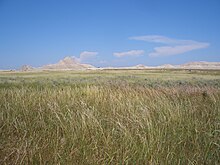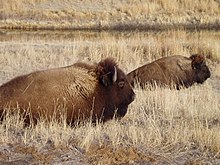Great Plains

The red line is the 100th degree of longitude.
The Great Plains ( German " Great Plains " ) are a dry area east of the Rocky Mountains in North America . In terms of nature, they are the classic prairies of the American West; today they are used intensively for agriculture. They range from the Canadian Prairie Provinces ( Alberta , Saskatchewan and Manitoba ) to Texas ; sometimes a small part of Mexico is also included.
The Great Plains cover an area of almost 2 million square kilometers and extend a total of about 500 km wide. While they are still around 1,600 m high on the Rocky Mountains , they drop to around 600 m to the east.
The Great Plains can be divided into two climatic regions, because west of the 100th degree of longitude there is a sparse average rainfall (less than 500 mm per year), whereas the eastern region has a comparatively humid climate. Accordingly, livestock farming dominates in the west and grain cultivation in the east.
Containment
The Great Plains are bounded to the north by the Canadian Shield and to the south by the coastal plain of the Gulf of Mexico .
The western border is formed by the Rocky Mountains. The eastern quarters of New Mexico , Colorado and Wyoming belong to the Great Plains as well as around two thirds of Montana . On the Canadian side, the south of Alberta , Saskatchewan and Manitoba are naturally within the Great Plains.
The eastern border is defined differently. Some geographers connect all the edges of the plain, which are at a height of 600 m, and define the resulting line as the eastern border, as in the green hatched graphic above. Others draw the border further east, depending on the extent of the high grass prairie, and consider North Dakota, South Dakota and Nebraska each to be completely part of the Great Plains. From this point of view, the north of Texas , the western half of Oklahoma , most of Kansas , the northern half of Iowa and the southwest of Minnesota also belong to the Great Plains.
history

The Great Plains were sparsely populated for a long time and were roamed by partially nomadic Indians on the hunt for bison and fork jacks . Only the horses brought to America by Europeans, which came to this area in the 18th century, made it possible for the Indians to settle more densely on the prairie and to develop the Plains Indians . Some peoples profited greatly from the new way of life, bison hunting on horseback. The previously weak Lakota and Comanche, for example, quickly developed into major power factors in the Midwest. The way of life of the Plains people was strongly based on the bison. They lived in tipis that were quick to assemble and dismantle, so they followed the buffalo.
In the mid-19th century, white settlers moved west through the Great Plains. For a long time the area was considered an uninhabitable wasteland. It was not until 1865 that many settlers settled in, who initially built sod houses as a cheap first home. The populations of bison fell sharply as a result of massive hunting, while the resident Indians were displaced into reservations until 1890 .
After extensive clearing of the prairie grass and droughts, soil erosion occurred. As a result, strong dust storms in the 1930s - especially between 1935 and 1938 - transformed parts of the Great Plains into a proverbial "dust bowl" (see Dust Bowl ). This led to mass misery among the farmers, who increasingly migrated to California.
While in 1950 just under five million people lived in the Great Plains area, in 2007 that number was around ten million. However, population growth was concentrated in a few metropolitan areas, primarily in Colorado and Texas . Settlements in the area and small towns lost a lot of inhabitants due to aging and rural exodus . Nearly two-thirds of all counties were affected by the population decline, in one in five counties it was even more than 50 percent. More and more small places are turning into ghost towns .
use
The agricultural use of the Great Plains can be roughly divided into two areas. While to the west of the 100th longitude there is mainly intensive animal husbandry in large fattening farms with little land use and extensive animal husbandry ( ranching ) with very large land use, to the east of the 100th longitude agriculture is the primary form of agricultural use. Mainly summer and winter wheat as well as maize and millet are grown . The reason for this distribution is the line with the same amount of precipitation ( isohyete with 500 mm), which runs almost parallel to the 100th degree of longitude and forms the limit for rain- fed agriculture without artificial irrigation.
The rainier east of the area, the so-called Grain Belt , is also known as the granary of the USA, or as a "breadbasket", since a huge surplus of agricultural products is generated in that region. About half of the wheat in the USA is produced in the Great Plains area, which corresponds to 68 million t for the entire USA (as of 2008), which corresponds to around 34 million t. In the western high plains , 60% of the US beef is produced, which is why this part of the great plains is often referred to as " cattle country ". As far as arable farming takes place in the west, it is usually made possible by artificial irrigation .

Increasing drought has made agriculture considerably more difficult in recent decades, and mechanization and automation have made labor redundant. The Ogallala aquifer , a deep groundwater layer , is almost exhausted due to its use for artificial irrigation. Cultivated land is already being transformed back into a grassy landscape on which bison breeding is increasingly being practiced. Under the name Buffalo Commons , it is proposed to convert large areas back into prairies, relocate people and reopen the areas for wild bison. Hunting and tourism could open up a new economic basis. In addition, the use of the Great Plains is increasingly focused on generating wind power .
This is countered by a trend of plowing under and intensively using areas in the northern parts of the plains that have not yet been used or that have only been used extensively and have therefore retained the character of grassland. The reasons are the promotion of the cultivation of energy crops and a special form of the state-subsidized crop failure insurance, which enables cultivation on marginal yield locations or even areas, whose cultivation could not be profitable without the insurance.
The Sandhills in Nebraska are among the largest regions of the Great Plains that have not been subject to agricultural use . It is a very large area of contiguous sand dunes, which are stabilized by low vegetation. 85 percent of this region therefore still has the original vegetation.
Soil protection
Due to various forms of erosion , measures had to be taken.
- No-till method (“Minimum Tillage”): The soil is worked without a plow in order to reduce or completely prevent soil erosion. This “conserved tillage” does not mean that the soil is no longer loosened, but that instead of a plow, other equipment such as B. a cultivator can be used. A deep loosening of the soil is mostly not necessary due to the gradually built up natural storage (optimal) if no mistakes are made in the cultivation.
- " Dry farming " describes an annual change between cultivation and fallow land. During the fallow year, the soil is kept free of weeds and deeply plowed. This makes the surface looser and larger, and the soil can absorb more moisture. To prevent evaporation, the soil is also harrowed and rolled after rainfall.
- The "Contour plowing" promotes the infiltration of water by contour line parallel furrows are drawn in the field, which slow down the water, so that the two forces of wind and water erosion is counteracted. Overall, however, the problem of wind erosion is much more difficult to solve than forms of erosion caused by water.
- Stubble mulching : During the fallow season , arable land is covered with straw ("stubble") and the stubble from the previous harvest is left standing. This is done not only with straw, but also with other mulches. This measure promotes the moisture absorption of the soil and reduces soil erosion.
- Windbreaks : Forest protection strips and windbreak hedges are created to reduce soil erosion.
- Strip Cropping : The soil is cultivated with plants of different ripening times to reduce soil erosion.
It is not uncommon for several of these soil protection measures to be used at the same time. The sole purpose of this is to obtain a higher level of effectiveness and to prevent another Dust Bowl scenario.
literature
- George Colpitts: Pemmican Empire: Food, Trade, and the Last Bison Hunts in the North American Plains, 1780-1882. Cambridge University, Cambridge 2018, ISBN 978-1-1076-2289-0 .
- David Stark (text), Nancy Warner (photographs): This Place, These People - Life and Shadow on the Great Plains , Columbia University Press, New York, 2014, ISBN 978-0-231-16522-8 .
- National Geographic: Great Plains - How the Heart of America is Changing . May 2004.
- David J. Wishart (Ed.): Encyclopedia of the Great Plains. University of Nebraska Press, 2004.
- Anne Matthews: Where the Buffalo Roam: Restoring America's Great Plains , TBS The Book Service Ltd; Reprint April 1993, ISBN 978-0-8021-3339-7 .
- USA - A geographic study of the country. Volume 1: The greater area in structural change . 1987.
Web links
Individual evidence
- ↑ John D. Unruh, Jr .: The Plains Across. The Overland Emigrants and the Trans-Mississippi West, 1840-60 . University of Illinois Press, 1993 (first printed in 1979), p. 30
- ↑ US Census Bureau: Population Dynamics of the Great Plains: 1950 to 2007 (PDF; 5.2 MB), Report P25-1137, July 2009
- ^ Food and Agricultural Organization of the United States (FAO)
- ↑ American Prospect: Plowed Under , April 2, 2014
- ^ WWF page on the Sandhills , accessed on May 19, 2013
Coordinates: 40 ° N , 102 ° W